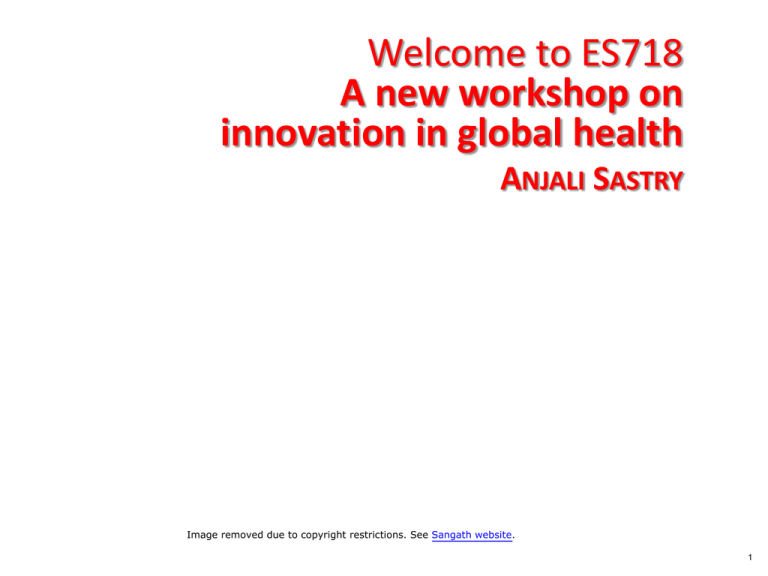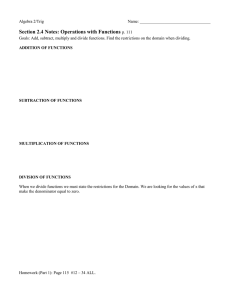
Welcome to ES718
A new workshop on
innovation in global health
ANJALI SASTRY
Image removed due to copyright restrictions. See Sangath website.
1
Plan for today
• First 70 minutes: Global Health briefing
• Next 50 minutes: in-class exercise to review
useful data sources
– you may step out for up to 10 minutes for a
mini-break
• last hour: share your review with
classmates, form teams, and plan for
tomorrow
2
what is global health?
3
Global health takes on health problems that cross national boundaries,
traditionally focusing on those that impose the greatest burden in
resource-limited settings. To address the challenges, the field now
encompasses a broad range of disciplines. Proponents have argued that it
should account for “cultural identities, political organizations,
transnational corporations, civil society movements and academic
institutions” (Frenk 2010), along with populations.
Recent reframings of global health place interdependence at the center. If
the origins and effects of many of today’s biggest health problems cross
national borders, then global health should be less concerned with
geographical location or stage of development, and more concerned with
the ways in which health issues are interconnected. This new definition of
global health thus aligns with calls for multilateral collaboration and
learning that flow both ways across state, sector, and socioeconomic
boundaries, and for recognizing “the many contributions of both
resource-rich and resource-scarce nations” (Fried et al, 10). In fact, some
argue that global health is (or should be) “collaborative trans-national
research and action for promoting health for all” (Beaglehole & Bonita,
10). Others note that acknowledging interrelationships requires equity to
factor into solutions (Frenk, 10; Piot & Garnett, 10).
Source: Sastry 2011
12-Jun-15
4
How long will you live?
Life expectancy at birth HVWLPDWHV. CIA - The World Factbook, 2008 via Wikimedia Commons. License: CC-BY-SA. This
content is excluded from our Creative Commons license. For more information, see http://ocw.mit.edu/help/faq-fair-use/.
Article and interactive map:
http://www.dailymail.co.uk/news/article-2240855/How-does-nation-rank-world-map-life-expectancy.html#ixzz2dy9R5IDx
5
maternal death
Chance of dying in childbirth
• in Boston
– 1 in 4,800
• In Burundi
– 1 in 16
• in Austria
– 1 in 21,500
A women’s lifetime risk of
dying from pregnancyrelated complications:
Niger: 1 in 7
Ireland: 1 in 48,000
• world
– 1 in 92
http://data.un.org/Data.aspx?d=SOWC&f=inID%3A132
http://www.who.int/making_pregnancy_safer/topics/maternal_mortality/en/
6
What’s the response?
7
Alma Ata Declaration 1978
Health for All in the 21st Century 1998
People’s Health Charter 2000
Millennium
Development Goals
2000
Universal Declaration of Human Rights 1948
8
UN Millennium Goals
• Goal 1: Eradicate extreme hunger and poverty
• Goal 2: Achieve universal primary education
• Goal 3: Promote gender equality and empower
women
• Goal 4: Reduce child mortality
• Goal 5: Improve maternal health
• Goal 6: Combat HIV/AIDS, Malaria and other diseases
• Goal 7: Ensure environmental sustainability
• Goal 8: Develop a global partnership for development
See http://www.un.org/millenniumgoals/pdf/(2011_E)%20MDG%20Report%202011_Book%20LR.pdf
9
Infographic removed due to copyright restrictions. See Institute for Health Metrics and
Evaluation (IHME). Millennium Development Goal 4: Accellerated Declines in Child Deaths.
10
IMPLEMENTATION GAP
11
Global health delivery failures
Intervention
Implementation
ARVs for PMTCT
Reduce HIV
transmission by 40%
9% coverage of women
overall and 50% of
women who test
positive in a clinic are
given ARVs for PMTCT
ITNs for Malaria
Prevention
Only 24% of children in
endemic areas sleep
under nets
Mothers to Mothers program © USAID
Kenya via Flickr. License: CC-BY-NC.
Reduce infant mortality
by 23%
Bed with mosquito netting courtesy
Joi Ito via Flickr. License: CC-BY.
source: Global Health Delivery Project
12
Vaccine-Preventable Deaths
© Copyright Sasi Group (University of Sheffield) and Mark Newman (University
of Michigan). Available under a Creative Commons NC license.
worldmapper.org
13
2008 data, courtesy of the Bill & Melinda Gates Foundation. Used with permission.
http://csis.org/event/rajeev-venkayya-global-health-delivery-systems
14
HOW DO YOU CHOOSE WHERE TO
FOCUS?
START WITH BURDEN OF DISEASE
15
Years of life lost by cause
Infographic courtesy of Elsevier, Inc., http://www.sciencedirect.com. Used with permission.
Source: "Global, Regional, and National Age–sex Specific All-cause and Cause-specific Mortality
for 240 Causes of Death, 1990–2013." The Lancet 385, no. 9963 (2015): 117–71.
The Lancet 2015 385, 117-171DOI: (10.1016/S0140-6736(14)61682-2)
16
Child death rates by region and cause in 2013
A: younger than 1 month
B: aged 1–59 months
The Lancet 2015 385, 117-171DOI: (10.1016/S0140-6736(14)61682-2)
Infographic courtesy of Elsevier, Inc., http://www.sciencedirect.com. Used with permission.
Source: "Global, Regional, and National Age–sex Specific All-cause and Cause-specific Mortality
for 240 Causes of Death, 1990–2013." The Lancet 385, no. 9963 (2015): 117–71.
17
Top 50 causes of
global years of life
lost in 1990 and
2013
Figure removed due to copyright restrictions. See Figure 10: "Global, Regional, and
National Age–sex Specific All-cause and Cause-specific Mortality for 240 Causes of
Death, 1990–2013." The Lancet 385, no. 9963 (2015): 117–71.
An interactive version of this figure is available at
http://vizhub.healthdata.org/gbd-compare/.
18
Change in life
expectancy at birth by
GBD region and cause
group from 1990 to 2013
Infographic courtesy of Elsevier, Inc., http://www.sciencedirect.com. Used with permission.
Source: "Global, Regional, and National Age–sex Specific All-cause and Cause-specific Mortality
for 240 Causes of Death, 1990–2013." The Lancet 385, no. 9963 (2015): 117–71.
An interactive figure with these data is available
at http://vizhub.healthdata.org/le. Changes in life
expectancy as a result of specific causes were
decomposed from the difference between allcause lifetables and cause-deleted lifetables
(mortality set to zero for a specific cause).
Because all changes in life expectancy are based
on cross-sectional lifetables, the cause-specific
changes add up to the total change in lifeexpectancy. NTDs=neglected tropical diseases
19
Quantifying the Burden of Disease from
mortality and morbidity
Disability-Adjusted Life Year (DALY)
Definition
•
One DALY can be thought of as one lost year of "healthy" life. The sum of these DALYs across the population, or the burden of
disease, can be thought of as a measurement of the gap between current health status and an ideal health situation where
the entire population lives to an advanced age, free of disease and disability.
•
DALYs for a disease or health condition are calculated as the sum of the Years of Life Lost (YLL) due to premature mortality in
the population and the Years Lost due to Disability (YLD) for incident cases of the health condition:
Calculation
•
The YLL basically correspond to the number of deaths multiplied by the standard life expectancy at the age at which death
occurs. The basic formula for YLL (without yet including other social preferences discussed below), is the following for a given
cause, age and sex:
where:
•
N = number of deaths
L = standard life expectancy at age of death in years
Because YLL measure the incident stream of lost years of life due to deaths, an incidence perspective is also taken for the
calculation of YLD. To estimate YLD for a particular cause in a particular time period, the number of incident cases in that
period is multiplied by the average duration of the disease and a weight factor that reflects the severity of the disease on a
scale from 0 (perfect health) to 1 (dead). The basic formula for YLD is the following (again, without applying social
preferences):
where:
I = number of incident cases
DW = disability weight
L = average duration of the case until remission or death (years)
http://www.who.int/healthinfo/global_burden_disease/en/
20
Figure showing Disability-adjusted Life Years (DALYs) by region removed due to
copyright restrictions. See: DALYs by region, 2012. World Health Organization.
http://www.who.int/gho/mortality_burden_disease/daly_rates/en/
21
Visualizations
Global Burden of Disease (GBD) Visualizations screenshot © IHME. All rights reserved. This content is excluded
from our Creative Commons license. For more information, see http://ocw.mit.edu/help/faq-fair-use/.
22
Age distribution of burden of disease by
country income group, 2004
5%
4%
13%
31%
35%
48%
56%
High-income Countries
8%
Low-and Middle-income Countries
60 years and over
5-14 years
15-59 years
0-4 years
Image by MIT OpenCourseWare.
Source data: World Health Organization. "The Global Burden of Disease, 2004 Update." WHO Press, 2004, p. 42.
http://www.who.int/healthinfo/global_burden_disease/2004_report_update/en/index.html
23
Births attended by skilled health
personnel
Low income
Middle income
Measles immunization coverage
among 1-year olds
Low income
Middle income
105
100
96
95
90
80
81
83
85
Rural
Urban
77
75
70
Percentage
Urban-rural
differences,
2000-2008
85
80
70
65
60
55
50
45
40
35
35
30
25
20
15
10
5
0
Rural
Urban
Rural
Urban
Rural
Urban
Urban-rural differences in the coverage of skilled attendant at birth and
measles immunization in low-income and middle-income countries2000-2008.
WHO, 2010
WORLD HEALTH STATISTICS
Image by MIT OpenCourseWare.
Source data: World Health Organization. "World Health Statistics 2010." WHO Press, 2011, p. 142.
24
SO, WHAT IS MOST NEEDED?
25
WE DEFINITELY NEED BETTER DATA
26
Map removed due to copyright restrictions. See "Civil Registration
Coverage of Cause of Death (%), 2005-2011."
27
Proportions of deaths covered by vital registration
(by GBD-2010 regions)
Courtesy of Byass et al., 2013. License CC-BY. Source: "Reflections on the
Global Burden of Disease 2010 Estimates." PLoS Medicine 10, no. 7 (2013).
TM
28
NEEDED INPUTS ARE MISSING
29
Doctors per person
• In Massachusetts? 4.69 (nonfederal) per 1,000
• In Malawi? 0.02
Part II. Global health indicator tables and footnotes
30
Infographic removed due to copyright restrictions.
Source: EuroRSCG Amsterdam, Netherlands. "Doctors of the World, Netherlands: Perspective."
http://adsoftheworld.com/media/print/doctors_of_the_world_netherlands_perspective?size=_original
31
MAYBE IT COMES DOWN TO MONEY:
NEED MORE ECONOMIC INPUTS
32
Public Health Spending
© Copyright Sasi Group (University of Sheffield) and Mark Newman (University
of Michigan). Available under a Creative Commons NC license.
www.worldmapper.org
33
Health Expenditure Per Capita (PPP;
International $, 2010)
World map depicting health expenditure per capita removed due to copyright restrictions.
Source: Kaiser Family Foundation. "Health Expenditure Per Capita (PPP; International $, 2010)."
http://kff.org/global-indicator/health-expenditure-per-capita/#
34
Comparing the US and Malawi
Malawi
US
% GDP on health
9.1
15.2
Percapita health spending (PPP
$)
49
7,164
Pvt spend as % of total
39.4
52.2
Children/woman
5.5
2.1
Gross nat’l income per capita
(PPP $)
760
45,640
% population living on under
PPP$1/day
73.9
-
Note 2008 & 2009 data. Source:
http://www.who.int/whosis/whostat/2011/en/index.html
35
Development Assistance For Health,
By Channel Of Assistance, 1990–2013.
Figure removed due to copyright restrictions. See Exhibit 1: Dieleman, Joseph L., et al. "Global
Health Development Assistance Remained Steady In 2013 But Did Not Align With Recipients’
Disease Burden." Health Affairs. 2014. doi:10.1377/hlthaff.2013.1432.
©2014 by Project HOPE - The People-to-People Health Foundation, Inc.
Dieleman J L et al. Health Aff doi:10.1377/hlthaff.2013.1432
36
Institute for Health Metrics and Evaluation (IHME). Financing Global Health 2013: Transition in an
Age of Austerity. IHME, University of Washington, 2013. Available at http://www.healthdata.org/
policy-report/financing-global-health-2013-transition-age-austerity. Used with permission.
37
Figure removed due to copyright restrictions. See Exhibit 3: Dieleman, Joseph L., et al.
"Global Health Development Assistance Remained Steady In 2013 But Did Not Align With
Recipients’ Disease Burden." Health Affairs. 2014. doi:10.1377/hlthaff.2013.1432.
http://www.healthdata.org/research-article/global-health-development-assistance-remained-steady-2013-did-not-align-recipients%E2%80%99
38
Institute for Health Metrics and Evaluation (IHME). Financing Global Health 2013: Transition in an
Age of Austerity. IHME, University of Washington, 2013. Available at http://www.healthdata.org/
policy-report/financing-global-health-2013-transition-age-austerity. Used with permission.
39
Institute for Health Metrics and Evaluation (IHME). Financing Global Health 2013: Transition in an
Age of Austerity. IHME, University of Washington, 2013. Available at http://www.healthdata.org/
policy-report/financing-global-health-2013-transition-age-austerity. Used with permission.
http://www.healthdata.org/sites/default/files/files/policy_report/2014/FGH2013/IHME_FGH2013_Chapter2.pdf
40
Top 20 countries by 2010 allcause burden of disease versus
cumulative 2009–2011 DAH
Institute for Health Metrics and Evaluation (IHME). Financing Global Health 2013: Transition in an Age of Austerity.
Seattle, WA: IHME, University of Washington, 2013. Available at http://www.healthdata.org/policy-report/financing
-global-health-2013-transition-age-austerity. Used with permission.
41
humoungous CAVEAT: Spending
does not equal health outcomes
42
Infographic removed due to copyright restrictions.
Source: Kane, Jason. "Health Costs: How the U.S. Compares With Other Countries."
October 22, 2012. PBS Newshour The Rundown (blog).
http://www.pbs.org/newshour/rundown/2012/10/health-costs-how-the-us-compares-with-other-countries.html
43
Infographic removed due to copyright restrictions.
Source: Kane, Jason. "Health Costs: How the U.S. Compares With Other Countries."
October 22, 2012. PBS Newshour The Rundown (blog).
44
Infographic removed due to copyright restrictions.
Source: Kane, Jason. "Health Costs: How the U.S. Compares With Other Countries."
October 22, 2012. PBS Newshour The Rundown (blog).
45
Table 1: Health Status of the United States and Rank among the 29 Other
OECD Member Countries removed due to copyright restrictions.
Source: Schroeder, Steven A. "We Can Do Better—Improving the Health of
the American People." New England Journal of Medicine (2007).
http://www.nejm.org/doi/full/10.1056/NEJMsa073350
46
Now go watch this!
Reducing child mortality – a moral and environmental
imperative
[15 minutes run time] September 27, 2010
Alternate link to the video
Many countries are making good progress towards MDG4
and it’s time to stop talking about Sub-Saharan Africa as
one place.
So, it’s not all bad news—and
Rosling makes stats
and data compelling!
For more Rosling, see http://www.gapminder.org/videos
http://www.gapminder.org/videos/reducing-child-mortality-a-moral-and-environmental-imperative/
47
MENTAL HEALTH
48
Mental health workforce shortages in
58 low- and middle-income countries
Figure removed due to copyright restrictions. See Figure 1: Bruckner, Tim A., et al.
"The Mental Health Workforce Gap in Low- and Middle-income Countries: A Needs-based Approach."
Bulletin of the World Health Organization 89 (2011): 184-94.
49
Table 1 removed due to copyright restrictions. See Table 1: Bruckner, Tim A., et al.
"The Mental Health Workforce Gap in Low- and Middle-income Countries: A Needs-based Approach."
Bulletin of the World Health Organization 89 (2011): 184-94.
The mental health workforce gap in low- and middle-income countries: a needs-based approach.
Full Text Available Academic Journal
(English) ; Abstract available. By: Bruckner TA; Scheffler RM; Shen G; Yoon J; Chisholm D; Morris J; Fulton BD; Dal Poz MR; Saxena S, Bulletin Of
The World Health Organization [Bull World Health Organ], ISSN: 1564-0604, 2011 Mar 1; Vol. 89 (3), pp. 184-94; Publisher: World Health
50
Organization; PMID: 21379414
Table 2 removed due to copyright restrictions. See Table 2: Bruckner, Tim A., et al.
"The Mental Health Workforce Gap in Low- and Middle-income Countries: A Needs-based Approach."
Bulletin of the World Health Organization 89 (2011): 184-94.
51
Table 3 removed due to copyright restrictions. See Table 3: Bruckner, Tim A., et al.
"The Mental Health Workforce Gap in Low- and Middle-income Countries: A Needs-based Approach."
Bulletin of the World Health Organization 89 (2011): 184-94.
52
Map removed due to copyright restrictions. See: "Age-standardized Suicide Rates (per 100
000 population), both Sexes, 2011." Mental Health. World Health Organization, 2014.
http://gamapserver.who.int/mapLibrary/app/searchResults.aspx
53
Map removed due to copyright restrictions. See: "Existence of a Mental
Health Policy, 2011." Mental Health. World Health Organization, 2014.
54
Map removed due to copyright restrictions. See: "Psychiatrists Working in Mental Health
(per 100 000 population), 2011." Mental Health. World Health Organization, 2014.
55
Graph removed due to copyright restrictions. See: "Rate of Mental Health Outpatient Facilities per
100 000 population, 2011: By WHO Region." Mental Health. World Health Organization, 2014.
http://apps.who.int/gho/data/node.main.MHFAC?lang=en
56
Key background knowledge you’ll need
1. India health outcomes; budget and government
2. technology, mHealth
3. innovations in mental health care; mental health
in India
4. India healthcare delivery (esp mental hlth),
service quality, HR, task shift
5. India health system
6. India social factors, poverty, equity
57
Next 40 minutes
Peruse your assigned materials, working in pairs
• Skim all articles
• Read several of them carefully
For your favorite readings, prepare a three-point
briefing
• What’s the particular resource about, in a
nutshell?
• What is really great/interesting/valuable?
• What is missing? (what do you wish you knew
more about?)
feel free to note pages or figures you think are most
useful
58
Form groups
• Please mingle and form teams of 4; there may
be one team of 5.
• Look for diverse backgrounds in your team
• You will work together tomorrow and
Wednesday.
• I will assign your topics shortly.
59
Aging
Alcohol use disorders, addiction
Child development and disability
Maternal mental health
OUR FOUR FOCAL AREAS ARE
GLOBAL NEEDS
60
61
Tonight’s assignment
Read the following:
• Patel on SUNDAR (2.5 pp)
• Sangath for MIT intro, biosketches, key concepts (10
pp)
• Sangath Biennial report (review map to p. 30; p. 34-43;
p. 47-60; p. 64-65; total 50 pages)
• Optional readings are also included in the folder
numbered 0.
Come to class with at least one question for Sangath
mapped out in writing. We kick off at 8 am with a joint
call to all seven experts assigned to work with us.
62
MITOpenCourseWare
http://ocw.mit.edu
15.ES718 Global Health Innovation: Delivering Targeted Advice to an Organization in the Field
Spring 2015
For information about citing these materials or our Terms of Use, visit: http://ocw.mit.edu/terms.




